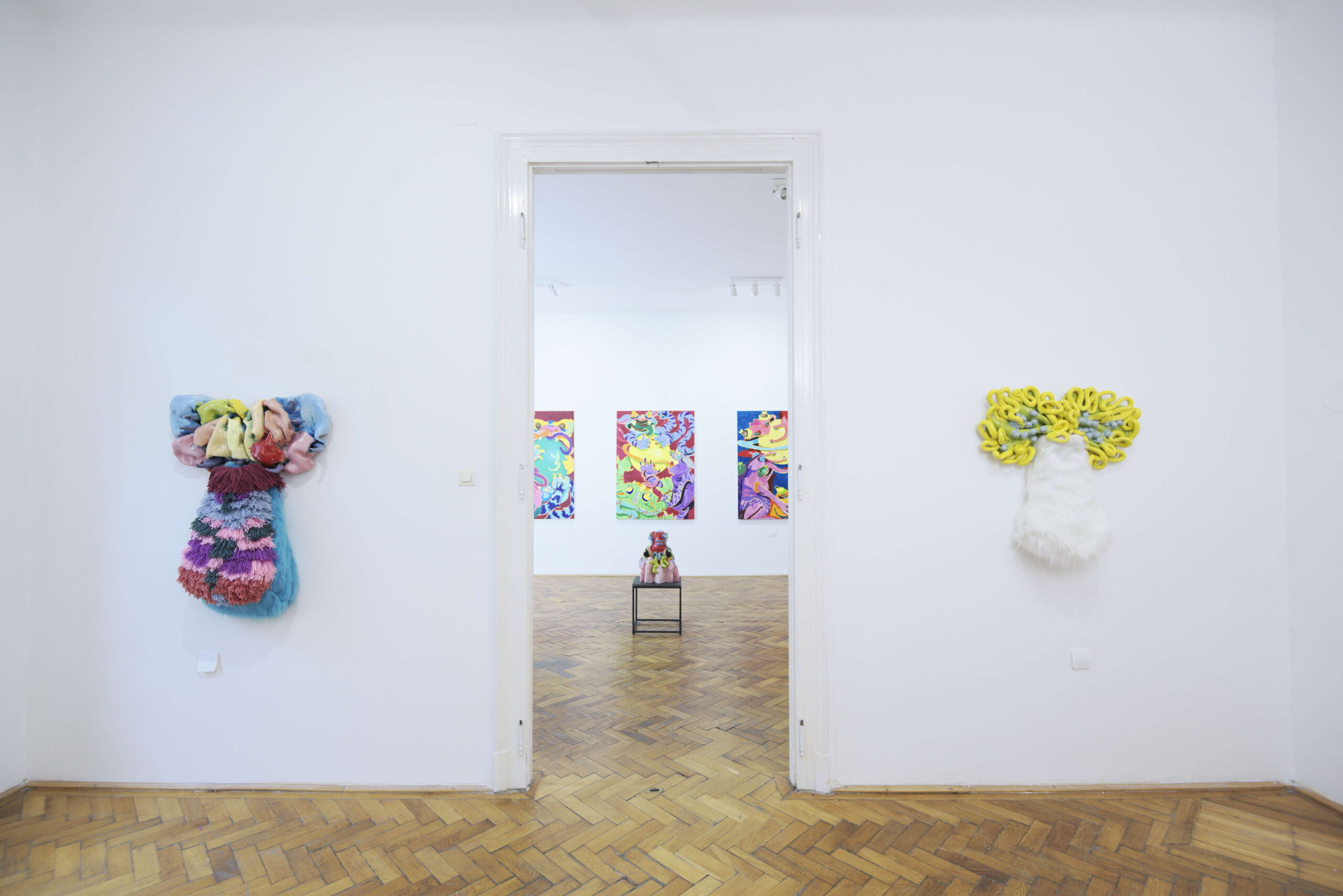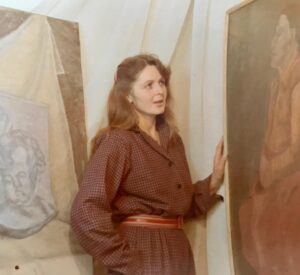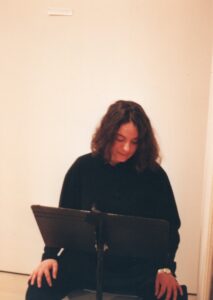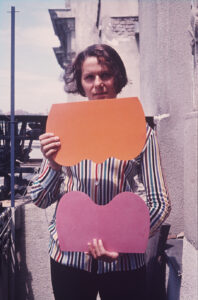Mira Makai
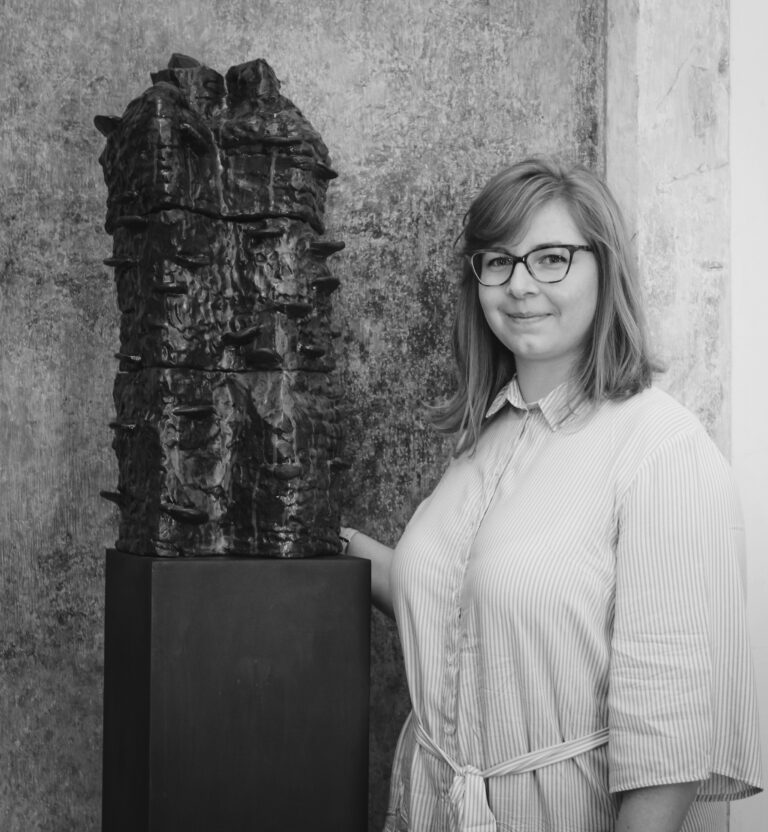
– born in 1990, Budapest, draws upon a variety of techniques, which she acquired from her studies in the printmaking department at the Hungarian University of Fine Arts. These techniques include working with oil on canvas, lithography, serigraphy as well as clay and it is the interaction of these techniques that shape her practice. Exploring and highlighting the thin border between the lush of life and the deadly rot, the atmosphere of her works can awake any inviting and repulsive feeling in the viewer. The chromatic associations she uses often offset the floral, vegetal and organic evocations summoned by the shape and volume of her sculptures. Ambivalent aesthetics constitute the backbone of her artistic production. Mira Makai lives and works in Budapest.
While making ceramic objects, I am often reminded of a childhood scene. When I was young, we went on holiday to the River Tisza, where my favourite game was to fool around with the wet sand of the riverbank. I liked to watch the watery silt first losing its sheen in my hand, then going dry, and finally displaying another of its qualities in its cracked and whitened form. This basic, fundamental experience has determined the basis of my attitude toward painting and sculpture. I like to imagine that in the prehistoric era, the birth of the first works of art might have happened the same way, and this is the feeling that I am generally looking for in my work. In my university years, after realizing numerous graphic prints and studies, I formulated a need for the creation/possession of objects. This was the main motivation behind my move to Munich to work on ceramics. I wanted to have something unique that had value in itself without being a multiple or being locked behind a frame. I immediately warmed up to ceramics, where works are enduring but really mouldable in all respects. First I planned to realize five or six designs, and their conception was preceded by a long preparation. After being confronted with the characteristics of the material and getting to know its nature, several options opened up for me. I was liberated from my fear of making mistakes and at once felt the product to be my own.
There is a vast number of variations possible in form and colour, as there is always the opportunity to incorporate new elements and combine surfaces and effects as well. When I open the door of the kiln after baking, I am both a creator and a viewer because I have to face my work as well as the contingency of the material. Being an artist is the main structure of my identity. My attitude to art also dominates the basic principles of my everyday life.
The forms used in my first sculptures (between 2014-2017) are based on a simple observation of nature. Therein reappear the treasures of natural museums that I loved to visit, such as the structure of minerals and rock, the details of prepared displays under glass and the transparent innards of amphibians in formaldehyde. My goal is to create a sort of personal Wunderkammer. What I deem important in these works is the duality manifested on the borderline between inviting, vibrant proliferation and revolting yet natural decomposition. It is in this frontier zone that I imagine these works, and pair up formal elements with colours and surfaces accordingly. The atmosphere of my works certainly can provoke both inviting and repulsive feelings in the viewer. As such, the observation of the border between the lush of life and the deadly rot is equally interesting to me. Balancing between these two poles is my daily gymnastics. I deliberately elaborate my works so as to obtain that ambivalent aesthetics, and I also do search for these values in other artworks12.
Around 2015, when I first made ceramic sculptures, I wanted to have my own little objects, small treasures. My goal was not to represent anything specifically, but to let the association of spots, prints and shapes appearing on the sculptures provoke something in the viewer. My abstract shapes gradually became the figures that I saw, discovered or perceived in them. From the very beginning, I made small “toy figures” for my own entertainment, based on my favourite animated films and videogames. These figures only fit on the shelves of my wall, even so, they are very important to me.
In early 2019, my attention turned to installations3. As an inner need of mine, I wanted to build my work around a specific theme, to add new references to my works, to bring in other possibilities for interpretation in addition to the visual world of natural history museums and palm houses. I decided to gather inspiration from the 3d environment, models and atmosphere of computer games – which I play a lot and know well from my free time – and incorporate certain of its motifs into my repertoire.
Due to the metallic colours and the rough forms I use, my large-scale installations evoke a virtual space, more precisely an imaginary cave or crypt that exists in the environment of a computer game. These installations reflect the way I play myself; I usually contemplate, look around a lot in these virtual environments and am always more interested in an object or a piece of equipment than in the main plot of the games45. This inspired me for the project entitled “dungeon & dragons”, a title that describes well my feelings about the process of creation and the sculptures that resulted from it. This project was topical to me because I found the unanimity of the conventions and expectations dictated by my society disturbing, and wanted to give a more conscious rhythm to my own life in order to get rid of the prescribed patterns. As others also expressed this need in my environment, I began to deal with social phenomena and patterns showing how the distance between the individual and reality became significant. This certainly is strengthened by the bubbles of social media, by the growing number of people watching more and more series or cartoons, by the existence of different traditional companies and subcultures, or even by the growth of the video game industry. Withdrawal in any form is possible. While each generation turns away from everyday reality in different ways, my age group is perhaps best characterized by migration to virtual space. This phenomenon is fascinating to me because it can parallel artistic activity in turning away from everyday life.
In addition to games, I always pay attention to the hottest trends, objects, phenomena, music performers, brands that are currently in the limelight, and condense my favourite patterns found during virtual or real reflections into my work. Resultantly, a character from Chinese mythology can mix with the visual language of cartoons and appear in colours rhyming with the world of the current running shoe fashion67. It gives me a lot of formal freedom to use these visual elements in an often unplanned, instinctive way, to make the fragments meet and mix spontaneously. Decoding these connections after the firing process is also a game for me and makes the surprise factor an integral part of my everyday life.
The statement was written in collaboration with curator Fruzsina Kigyós (2021).
1Image: Míra Makai, Column XVI, 2018, glazed ceramic, 40 x 65 x 40 cm. Courtesy of the artist.2Image: Míra Makai, Gem-shell VII, 2018, glazed ceramic, 40 x 25 x 25 cm. Courtesy of the artist.
3Image: Míra Makai, The Gate, 2020, ceramic installation. Courtesy of the artist.
4Image: Míra Makai, Moth I, 2020, ceramic-textile, 80x90 cm. Courtesy of the artist.
5Image: Míra Makai, Moth III, 2020, ceramic-textile, 80 x 100 cm. Courtesy of the artist.
6Image: Míra Makai, installation views of the exhibition “Treasure hunt”, Four Room Gallery, Budapest, 2020. Courtesy of the artist.
7Image: Míra Makai, installation views of the exhibition “Treasure hunt”, Four Room Gallery, Budapest, 2020. Courtesy of the artist.
– szül. 1990, Budapest, a Magyar Képzőművészeti Egyetem Képgrafika szakán tanult, az ott elsajátított technikát – festészet, litográfia, szerigráfia, kerámia – ötvöződnek alkotásaiban, és egymásra hatva alakítják művészeti praxisát. Alkotásai az élet bujasága vagy olykor a halálos rothadás vékony határait feszegetve hívogató atmoszférát, visszataszító érzést ébreszthetnek a nézőben. A művész által alkalmazott színtársítások gyakran ellensúlyozzák a szobrok alakzatainak virágos, növényi és organikus formáit. Az ambivalens esztétika alkotja a művészi alkotásainak gerincét. Makai Mira Budapesten él és dolgozik.
Kerámia tárgyak készítése közben gyakran eszembe jut egy gyermekkori jelenet. Fiatal koromban a Tisza folyóhoz mentünk nyaralni, ahol a kedvenc játékom az volt, hogy a folyópart nedves homokjával játszottam. Szerettem nézni, ahogy a vizes iszap először elveszti fényét a kezemben, majd kiszárad, és végül egy másik minőséget mutat repedezett és fehérített formájában. Ez az alapvető tapasztalat határozta meg a festészethez és a szobrászathoz való hozzáállásom alapjait. Szeretem elképzelni, hogy az őskorban az első műalkotások születése ugyanúgy történhetett, és ez az az érzés, amelyet általában a munkámban keresek. Az egyetemen töltött éveim alatt, számos grafikai nyomtatvány és tanulmány megvalósítása után megfogalmaztam a tárgyalkotás / birtoklás igényét. Ez volt a fő motivációm a müncheni költözésem hátterében, hogy kerámiával foglalkozzak. Szerettem volna valami egyedülállót, amelynek önmagában is értéke van, anélkül, hogy sokszorosítva lenne, vagy hogy egy keret közé lenne zárva. Szinte azonnal a kerámiához értem, ebben a műfajban a művek tartósak, de ugyanakkor minden szempontból formálhatók. Először öt-hat tervet akartam megvalósítani, és a megépítése hosszú előkészületek előzték meg. Miután szembesültem az anyag jellemzőivel, megismertem a természetét, számos lehetőség nyílt meg előttem. Felszabadultam a hibázástól való félelmemtől, és egyszerre a sajátomnak éreztem az anyagot.
Formában és színben nagyon sokféle variáció lehetséges, mivel mindig lehetőség van új elemek beépítésére, valamint a felületek és ezek hatásainak a kombinálására is. Amikor sütés után kinyitom a kemence ajtaját, alkotó és néző is vagyok, mert szembe kell néznem a munkámmal, valamint az anyag esetlegességével. Művésznek lenni identitásom fő eleme. A művészethez való hozzáállásom a mindennapjaim alapelveit is uralja.
Az első szobraimban használt formák (2014-2017 között) a természet egyszerű megfigyelésén alapulnak. Ezekben a művekben ismét megjelennek azok a természeti múzeumok kincsei, amelyeket imádtam meglátogatni, mint például az ásványok és a kőzetek szerkezete és az üveg alatt látható kétéltűek átlátszó formaldehidben. Egyfajta személyes Wunderkammer létrehozására törekszem. Amit fontosnak tartok ezekben a munkákban, az a kettősség, amely az élénk burjánzás és a mégis természetes bomlás közötti határvonalon nyilvánul meg. Ebben a határzónában képzelem el ezeket a műveket, és ennek megfelelően párosítom a formai elemeket színekkel és felületekkel. Munkáim hangulata minden bizonnyal buja és visszataszító érzéseket is kiválthat a nézőben. Számomra ugyanolyan érdekes a burjánzó élet és a halálos rothadás között húzódó határ megfigyelése. A két pólus közötti egyensúly a mindennapi gyakorlatom. Szándékosan építem fel műveimet, hogy elérhessem ezt az ambivalens esztétikát, és ezeket az értékeket más műalkotásokban is keresem12.
2015 körül, amikor először készítettem kerámia szobrokat, szerettem volna saját kis tárgyakat, kis kincseket alkotni. Nem az volt a célom, hogy bármit is ábrázoljak, hanem az, hogy a szobrokon, nyomatokon és formákon megjelenő foltok asszociációja előidézzen valamit a nézőben. Absztrakt formáim fokozatosan azokká az alakokká változtak, amelyeket láttam, felfedeztem vagy érzékeltem bennük. A kezdetektől fogva kis „játékfigurákat” készítettem saját szórakoztatásomra, kedvenc animációs filmjeim és videojátékaim alapján. Ezek az alakok csak a falam polcain férnek el, de ennek ellenére is nagyon fontosak számomra.
2019 elején figyelmem az installációkra3 irányult. Belső szükségletként szerettem volna munkámat egy konkrét téma köré építeni, új hivatkozásokkal gazdagítani a műveket, a természettudományi múzeumok és pálmaházak világán kívül más referenciákat is behozni az alkotási folyamatba. Ekkor döntöttem úgy, hogy inspirációt gyűjtők a számítógépes játékok 3D-s környezetéből, modelljeiből és hangulataiből, amelyek jól ismertek szabadidős tevékenységemből, és beépítek bizonyos motívumokat vizuális eszköztáramba.
A z általam használt fémes színek és durva formák miatt nagyszabású installációim leginkább egy virtuális térhez, pontosabban egy számítógépes játék kontextusában létező képzeletbeli barlanghoz / kriptához társíthatók, és tükrözik azt is ahogy én szoktam játszani. Általában szemlélődöm, sokat nézek körül a videojátékok környezetében, és mindig jobban érdekelnek az eszközök, a felszerelések különböző darabjai, mint a játékok fő cselekménye45. Ez inspirált a „börtön és sárkányok” című projekthez, a cím jól leírja a munkafolyamat és az elkészült szobrok iránti érzéseimet. Ez a projekt számomra azért volt aktuális, mert zavarónak találtam a társadalom által diktált konvenciók és elvárások egyhangúságát, és tudatosabb ritmust akartam adni saját életemnek, hogy megszabaduljak az előírt mintáktól. Mivel a környezetemben mások is kifejezték ezt az igényt, elkezdtek foglalkoztatni olyan társadalmi jelenségek, minták, amik láthatóvá tették az egyén eltávolodását a valóságtól. Ezt minden bizonnyal felerősítik a közösségi média buborékjai, a sorozatokat és rajzfilmeket nagy mennyiségben néző emberek növekvő száma, a különböző hagyományos vállalkozások/szubkultúrák létezése, vagy akár a videojáték-ipar növekedése. Bármilyen formában el lehet fordulni a valóságtól. Míg minden generáció más-más módon teszi ezt, korosztályomat talán legjobban a virtuális térbe való vándorlás jellemzi. Ez a jelenség elbűvölő számomra, mert a művészi tevékenység és a szokásos életmódtól való elfordulás párhuzamossá válhat.
A játékok mellett mindig figyelek a legújabb trendekre, tárgyakra, jelenségekre, zenei előadókra, márkákra, amelyek jelenleg az érdeklődés középpontjában állnak, és virtuális vagy valós reflexiók során talált kedvenc mintáimat sűrítem munkámba. Így fordulhat elő, hogy a kínai mitológia szereplője keveredik a rajzfilmek vizuális nyelvével, és olyan színekben jelenik meg, amelyek a jelenlegi futócipő divat világával azonosak67. Nagy formai szabadságot ad számomra, hogy ezeket az referenciákat gyakran nem tervezett, ösztönös módon használom, valamint hogy a különböző vizuális elemek spontán módon találkoznak és keverednek. Ezeknek a kapcsolatoknak a dekódolása a kerámiák égetése után szintén játék számomra, így a meglepetés élménye átszövi mindennapjaimat.
A statement Makai Míra és Kigyós Fruzsina kurátor együttműködésében valósult meg (2021).
1Kép: Makai Míra, Oszlop XVI., 2018, mázas kerámia 40 x 65 x 40 cm. A művész jóvoltából.2Kép: Makai Míra, Drágakőhéj VII., 2018, mázas kerámia, 40 x 25 x 25 cm. A művész jóvoltából.
3Kép: Makai Míra, A kapu, 2020, kerámia installáció. A művész jóvoltából.
4Kép: Makai Míra, Lepke I.2020, kerámia, textil, 80 x 90 cm. A művész jóvoltából.
5Kép: Makai Míra, Lepke III., 2020, kerámia, textil, 80 x 100 cm. A művész jóvoltából.
6Kép: A “Kincsvadász” c. kiállítás enteriőr fotói, Négyszoba Galéria, 2020. A művész jóvoltából.
7Kép: A “Kincsvadász” c. kiállítás enteriőr fotói, Négyszoba Galéria, 2020. A művész jóvoltából.
